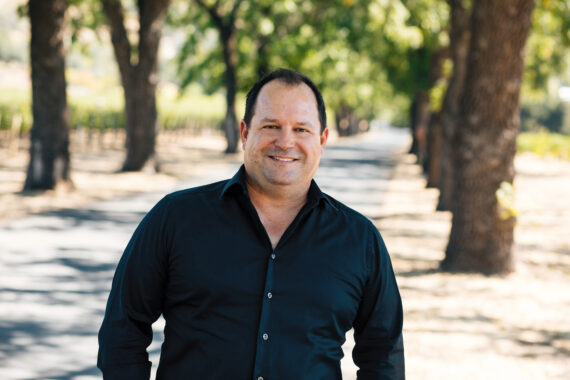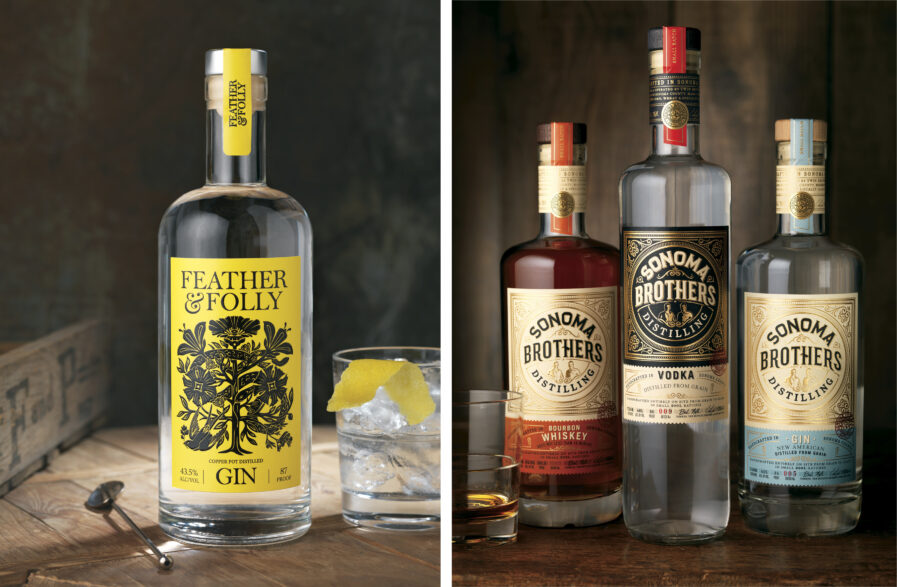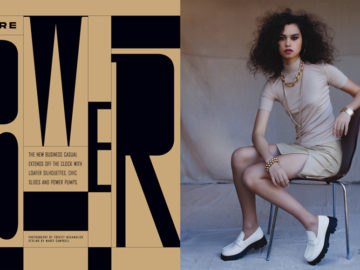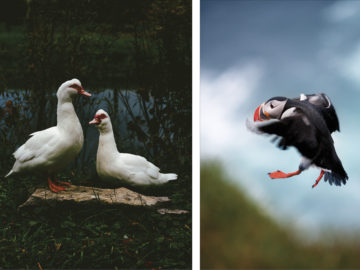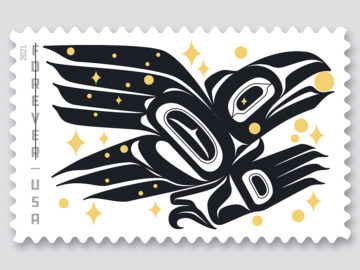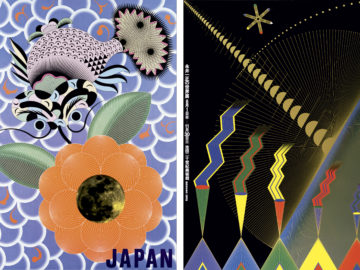Under David Schuemann’s guidance, CF Napa Brand Design has redefined alcohol beverage branding, earning global accolades and being featured in renowned museums. As the force behind the studio, David’s expertise has helped shape branding in the spirits industry. Read more in our latest Graphis Journal Q&A to explore his insights and CF Napa’s influential journey.
Introduction by Bob Davids Founder & President, Sea Smoke Cellars
I met David while looking for a graphic designer for Sea Smoke; I couldn’t do the job because I have a daughter with a design degree from the Art Institute in San Francisco and had a son-in-law with a graphics degree from ArtCenter College of Design. To keep the peace, I decided to take on a leadership role and remove all family members from the project. I needed to stay objective, so I interviewed several designers with wine label experience. I found David and his partner (another ArtCenter grad), and we got started. Our family spent a year getting the Sea Smoke brand name, which was a process that took several meetings. It took another 18 months to finish the label. All the names of our wines came from family members except for David’s CF Napa partner, who suggested the name Southing: it’s a British sailing term for ‘heading South,’ and all of our vineyards have south-facing slopes. When I gave David the assignment, I told him I wanted the name coming forward out of a cloud of fog. Dave faxed me 18 ruffs, and I told him his staff needed to get more ‘out of the box’ and to also reach out to Doyald Young, the head of graphic design at ArtCenter, who had just retired. Doyald made about 900 ruffs. Then, one day, he faxed over a dozen more ruffs. I immediately called Doyald and told him, “That’s it! Number six.” He said he could improve it, and I told him not to change a thing. That image was given to David, who made a camera-ready label. It went through a lot of quality detail scrutiny with the family, but we got it. The corporate ID for the brand was a two-year overnight success. David and CF Napa assembled the label with great precision. There are subtle nuances, including each flourish having a different screen percentage to give movement (three values of ink). There is metal foil over imboss/deboss stamping on non-coated paper. Their expertise is in the negative spacing. David and CF Napa nailed it!
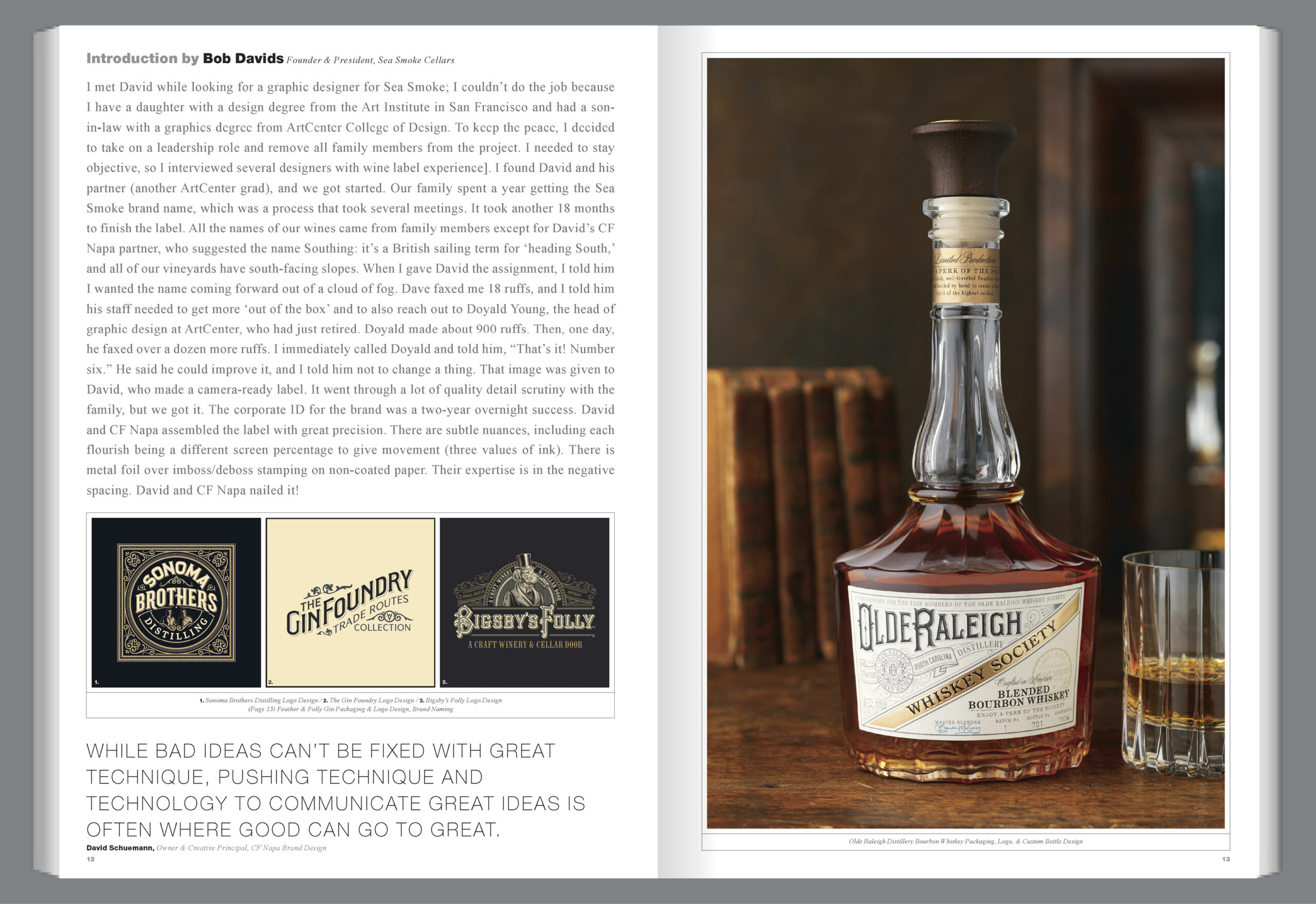
What inspired or motivated you to have a career in design?
I was fortunate to have some great teachers in middle school and high school who discovered and directed my talent early on. My middle school art teacher unearthed my drawing ability and introduced me to graphic design, my lifelong love. I had a high school teacher who involved me in jewelry design, which sparked my understanding of materials and how design could be three-dimensional. I think so many of us would not be where we are without a teacher at some point encouraging us. I am a huge supporter of art in school and believe these early experiences can nourish young artists.
What is your work philosophy?
1. Drink With Your Eyes®. I believe that to create a brand that truly resonates with a consumer, it must be far more than simply a decorative exercise. The most successful brands place themselves at the intersection of a market opportunity and the consumer’s lifestyle and then thrill the consumer with design. There has to be a strategic and intellectual concept first. Then, that strategic vision is brought to life through storytelling and evocative design. The magic lies in expressing the brand story without a single written word. When done correctly, a brand can nearly sell itself. This is what we refer to at CF Napa as the “Drink With Your Eyes®” philosophy.
2. Work Hard and Love What You Do. My father always said, “Work hard and do what you love, and you’ll get lucky.” Simply working harder than most people is a powerful tool that will get you far ahead of most of your competition. I don’t believe working harder equals longer hours, which, I find, is a unique philosophy in an industry overrun by long hours and burnout. At CF Napa, I’m passionate about teaching creatives how to learn the discipline of being voracious during normal business hours and then leaving on time to allow themselves both the physical and mental rest to recharge their creativity and soul, so we seldom work more than an eight-hour day and never work weekends.
3. Collaboration. I believe the absolute best solutions come from teamwork and collaboration. Pushing good ideas and designs to be great within a team and with the client, challenging assumptions, and removing self-imposed barriers and rules is a proven recipe for success. I’ve never found that the best solution comes from an individual.
4. The Devil is in the Details. Packaging in the alcohol business is unique from many other sectors in its high-end finishes—custom bottles, extremely high-end pieces, print techniques, and treatments. Even the smallest of details can have massive payoffs. While bad ideas can’t be fixed with great technique, pushing technique and technology to communicate great ideas is often where good can go to great. This is what drew me to the alcohol sector and keeps me coming back every day.
5. Be an Expert. I believe striving to be an expert is where success lies. I love focusing on one industry and learning everything I can about it, helping others succeed, and leading where the industry can go. I see being an expert not as a destination but as a continuous lifelong journey of learning. Taking risks, pushing boundaries, and avoiding formulas have been my keys to success and becoming a leader.
Who is or was your greatest mentor?
I’ve had so many great mentors that, in many ways, this is a difficult question to answer. I attended college at UW Eau Claire, a small state school in northern Wisconsin. I was unbelievably fortunate to have an amazing professor, John Lawler, who had a Master’s from Pratt Institute in New York. He pushed me in ways I could never have imagined. Early in my career, the design lead at a large marketing agency, Carlson Marketing Group, took a chance on me and encouraged me to leave my job at a record label and set my sights on building larger brands. She taught me how to harness my thinking into amazing designs and, more than anything, to believe in my talent. I would not be where I am today without her guidance. Later, after purchasing CF Napa, I attended the AIGA Harvard program and interacted with Michael Bierut of Pentagram NY, who was also attending. I was captivated by his view on solving problems through design and his desire to diagram the creative process in a way that a client could understand. So many of my contemporaries challenge me every day. It’s an amazing time to be working in the alcohol space.
What is the most difficult challenge you’ve had to overcome to reach your current position?
I was recruited into CF Napa to be one of two creative directors who would be groomed to replace the current principals upon their retirement. After a year in the creative director position, the principals let us know that our parent company had divested our New York and Napa offices, and we were to close within days. You can imagine the stress, as my wife and I had just moved to Napa from San Francisco. I had never envisioned myself as an owner of an agency, and making that transition to ultimately finding a way to purchase the agency successfully was challenging—one with many turns and disappointments. I started with a partner and bought him out a year later with nearly non-existent money. Failure was everywhere, and the stress was unrelenting. Through the experience, I made a lot of mistakes and learned the hard way many times, but I discovered my leadership skills. I rebuilt a team and set my sights on winning back many clients who had left. I decided to focus only on the alcoholic beverage sector. The rest is history, as they say. After 20-plus years of owning CF Napa, I think the hardest part is letting go of the missteps along the journey and instead focusing on retaining the lessons I’ve learned.
Who among your contemporaries today do you most admire?
There is so much good work being done these days, but honestly, I don’t spend a lot of time looking at the work of other design firms. That said, the agencies I currently find consistently inspiring are Force Majeure, Stranger & Stranger, Denomination, and Chad Michael Studio.
Who have been some of your favorite people or clients you have worked with?
Over the years, our favorite clients have always been the ones who come to us seeking our expert opinion. They value our insights, challenge us to stretch the possible and common assumptions, and view success as a true collaboration. Specifically, naming clients is hard, and as much of a cop-out as it may sound, we have so many favorites. Certainly, Sea Smoke Cellars is one who truly trusted us with their vision and allowed us to work with the late Doyald Young, a personal hero of mine and a savant in the world of hand-drawn typography. Working with Doyald will be something I’ll always cherish, and having him publish our work in one of his final books is a treasure for me. One of our newer clients, Corning & Company, has become an amazing partner and is developing multiple spirits brands with us. Our relationship has progressed to the point where we are brought in to vet ideas and opportunities long before there is a project. We feel as if we have a seat at the table as a consultant in driving their business. If there were ever a client that we wish would write a “How to be a Great Client Handbook,” it would be them. We have several current clients (who would prefer to stay confidential) who are large investors across many sectors and are newcomers to the alcohol space. It’s a trend we’re seeing where financial investors are developing alcohol brands into large portfolios to be grown and ultimately sold. They have the capital to develop brands the right way, take their time to get it perfect, and come to us with a multi-year vision of how we can build success together.
What are the most important ingredients you require from a client to do successful work?
We require complete honesty and collaboration—to the extent that clients are clear on their objectives, what success looks like for them, and what they can implement within their budgets—and for them to dream of what the future could look like. We want clients that trust us and ones that hold us accountable. Success is often a multi-stage process and not a one-and-done scenario. Our best clients are the ones who are completely honest with us, even if the answers are not what we want to hear. We can only be successful together. Clear and honest communication is really at the heart of all great collaborations.
As one of the worldwide leaders in alcoholic beverage branding, what makes your firm stand out from similar companies?
I made the decision when I purchased CF Napa over 20 years ago that we would specialize exclusively in alcohol and become experts. In a time when diversification was the rage, this was a very countercultural view in business. I truly feel like an expert in a sector; one must focus on learning everything about that sector to become a leader in it. Over the past two decades, we have developed a process that intertwines strategy and storytelling to develop the ethos of a brand and its primary ecosystem. The key output is the stickiness of how the brand will connect with its primary consumers so that they feel it was made specifically for them. Because of this, we’ve never developed a “house look” or style. Our portfolio is as diverse as the brands we’ve helped develop. This has catapulted us from a regional player to one of the firms sought out regularly by companies internationally.
Napa Valley is well-known for its wine both across the nation and internationally. Is there any pressure to live up to that reputation?
Napa Valley is one of the most recognized brands on the face of the earth, and anytime you are “playing” on the world stage, there is pressure to perform your best. The brands developed here are watched and collected by the world. Because of this, we feel even more of a responsibility to make sure our work is congruent with the world-class quality of these wines. CF Napa was born in the Napa Valley, is part of our namesake, and, for over nearly 50 years, has become our conduit for working with international clients.
Do you only work with wine or with other alcoholic beverages as well?
We work in all categories of alcoholic beverages. We also work with associated industries and have worked with wine barrel companies, closure companies, and distributors. We’ve also developed brands for retailers and control states.
You’ve published a book, 99 Bottles of Wine. Why publish a book, and what was the process like?
It was an incredible experience, but it was more difficult than we had originally calculated. Determining the brands to be included was a challenge, given the years of work we wanted to capture. The hardest part was that the book concept was a series of 99 short stories about the projects showcased. We found that to write this book, we needed to write about 150 short stories and cull them down to 99. It was a labor of love that we are proud of, but to design and write the book while continuing our work for clients was a massive effort. We’re about to embark on another book, so apparently, we haven’t learned our lesson.
What is the greatest satisfaction you get from your work?
We certainly love the recognition from our peers, and awards are also great. Our team has changed over the years, and I’m blessed to have worked with so many talented designers. What I get the greatest satisfaction from is growing designers into superstars while making a significant impact on the trajectory of so many brands. Watching sales soar after a launch or relaunch, helping brands become incredibly commercially successful, and helping other entrepreneurs reach their dreams—that’s the thing that keeps me coming back for more.
What part of your work do you find most demanding, considering your position?
Building and nurturing people is, by far, the most difficult challenge when running a business. I spend a huge amount of time focusing on this every day, learning, listening, and challenging my assumptions. The past few years with the pandemic have changed so much of what I thought was sacred and, in other ways, solidified other beliefs even more. Great teams are what breeds success. Collaboration is key, and some of that cannot be attained remotely as successfully or as easily as in person. Learning how to approach this with both in-person and remote employees has been eye-opening and has changed our agency forever.
What advice do you have for design students?
Be voracious learners, leave your ego at home, take more chances, and be willing to fail—failing is natural and an opportunity to learn. Playing it safe will not get you to where you want to be. Work hard and listen intently to the people you respect. They have so much to teach you if you can open yourself to what they have to tell you.
Over the past 21 years, David Schuemann has led CF Napa to become one of the world’s preeminent brand agencies specializing in the alcohol beverage industry. CF Napa’s work has earned recognition from nearly every major design competition, has been showcased in the Museum of Modern Art, and is part of the permanent collection at the Cooper Hewitt Design Museum in New York City, the Smithsonian, and the American Design Archives at the Denver Art Museum. David authored 99 Bottles of Wine: The Making of the Contemporary Wine Label, writes regularly for numerous periodicals, and is a regular industry speaker.
